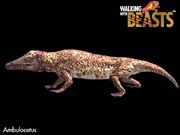Looking for all the world like a Giant Otter crossed with a Crocodile, Ambulocetus, provides scientists with the

answer to how Whales evolved. This, quite bizarre creature, was over 3 metres long, and most certainly lived a semi-aquatic existence. Ambulocetus, is in fact one

Ambulocetus
of the very earliest, if not the very earliest forms of Whale (Cetacean) The still land worthy legs of Ambulocetus, contribute to the beast's name, which means, 'Walking Whale'. Evidently Carnivorous, this amphibious mammal, seems to Palaeontologists to have been a formidable and powerful ambush predator. Possibly waiting for prey to drink at the body of freshwater it was occupying, Ambulocetus may have used its vice-like jaws to clamp onto helpless prey, which was to then be dragged underwater to be rather grimly drowned. This seems more than likely, and is a tactic employed by the neighbours Ambulocetus would have had in the lakes and rivers - Crocodiles. However, they would probably flee when Ambulocetus came close, as the mammalian predator was even more powerful than them. What is particularly interesting about the diet of Ambulocetus, is that it appears to be one of the few mammals at the time that had evolved to kill large prey. Living during the Early Eocene Epoch, in later times, the descendants of Ambulocetus would adapt to cope with Saltwater, and grow into massive sizes, so familiar in Whales to us. Even so, Ambulocetus had evolved from the most unlikely mammals of all - rodent-like mammals, which evolved into small carnivorous forms, which then opted to exploit the relatively empty niche in the water; where Giant Terror Birds such as Gastornis could not catch them.